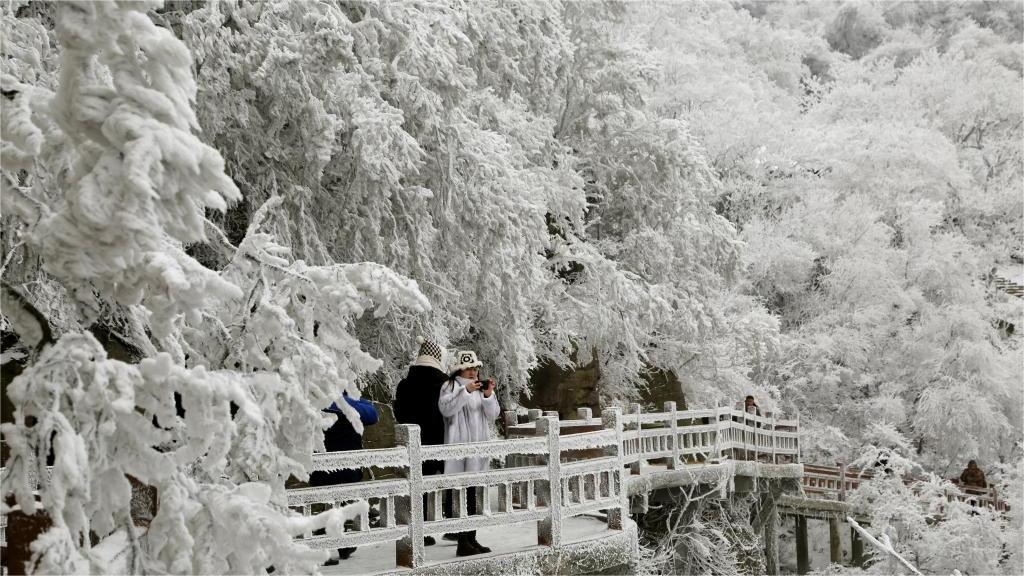China strives to promote local tourism with quality service and cultural riches
HARBIN, Jan. 24 (Xinhua) -- With China's northeastern city of Harbin gaining prominence as a top winter destination, tourism bureaus nationwide are actively promoting local attractions and employing innovative strategies to entice visitors.
Featuring unique local traditions such as distinctive dressing-up, traditional dances and delectable cuisine, these efforts aim to captivate tourists in the lead-up to the week-long Spring Festival holiday.
Liu Hong, head of the culture and tourism bureau of the Garze Tibetan Autonomous Prefecture in southwest China's Sichuan Province, has recently become a social media "celebrity" after a video of him strolling with a horse in a Tibetan robe and dressed as a swordsman while on a raft went viral on social media.
"I would like to be a social media 'celebrity' so long as I can promote my hometown Garze," said the 52-year-old official, who has 2.6 million followers on Douyin, the Chinese version of TikTok, and his videos have been viewed more than 2 billion times.
He is not alone in this trend, as tourism officials across China have jumped onto the bandwagon. For instance, Gao Sisheng, head of the Linyi culture and tourism bureau in eastern Shandong Province, showcased his calligraphy skills to attract visitors. Similarly, Du Bo, head of the culture and tourism bureau of Tahe County in Heilongjiang Province, transformed into a "white deer fairy" donning the traditional dress of the Oroqen ethnic minority to showcase the icy beauty of her hometown. And the culture and tourism bureau head of Acheng District in Harbin Wang Dianyou performed hip-hop dance for visitors.
Wang Hongxin, head of the Harbin bureau of culture, broadcast, television and tourism, even interacted with tourism officials from Switzerland, inviting foreign visitors to the snow world.
As officials diligently engage in tourism promotion efforts, film stars have also been urged to promote their hometowns. Superstar Andy Lau promoted his native Guangdong in southern China, and acclaimed actress Angie Chiu represented central Henan Province. During his concert in Chengdu, the capital of Sichuan, singer Eason Chan explored local attractions, sparking online buzz, with the hashtag "Eason Chan citywalk" trending on social media.
Numerous events launched by local tourism authorities have garnered widespread attention, both online and offline.
In the historic city of Xi'an in the northwestern Shaanxi Province, dancers dressed up as the Terracotta Warriors and Emperor Qinshihuang, who unified China for the first time, to present the popular "Subject Three" dance in an antique street, attracting numerous viewers on China's social media platforms.
Likewise, Luoyang City in Henan, an ancient capital for centuries, has dispatched a group of young men wearing resplendent golden warrior armor to warmly greet visitors at the high-speed railway station. They are tasked with distributing travel brochures and assisting people with luggage. The city's cultural and tourism bureau has also initiated an innovative campaign, presenting artificial gemstones to tourists who successfully answer questions about the local culture.
At a fashion show in Harbin, performers dressed in the traditional fish-skin clothes of the Hezhe ethnic group and wearing silver headgear of the Yi ethnic group showcased their culture, wowing visitors.
"Tourists nowadays are increasingly interested not only in the culture, history and natural resources of their destinations but also in the local lifestyle, services and the attitudes of the people there," said Yu Zhigang, head of the College of Economics and Management in the Northeast Agricultural University.
Speaking about her experience, Wang Hejing, a tourist from the eastern Anhui Province, located more than 2,000 km away from Harbin, said she fell in love with the "ice city" and was overwhelmed with joy to get free taxi rides and free hot water by locals during her trip.
"We enjoyed the songs by local ethnic groups, and received specialties distributed in the city's main avenue," she said, adding that Heilongjiang is a very welcoming province rich in culture and resources.
Harbin's popularity among tourists has certainly skyrocketed. During the three-day New Year holiday, it received more than 3 million visitors, raking in 5.91 billion yuan (about 831.8 million U.S. dollars) of tourism revenue. Both the number of tourists and the amount of tourism revenue surpassed the figures for 2019, marking a historical peak.
Dai Bin, president of the China Tourism Academy, has predicted that total domestic travel will exceed 6 billion visits in 2024 and domestic tourism revenue is likely to surpass 6 trillion yuan.
As Liu Hong sees it, the key factor contributing to Harbin's tourism success is the high-quality service provided to visitors. "We need to strive to improve the quality of service. After you tried everything to bring in visitors, you have to ensure that they have a good experience and would like to speak positively for you."
According to him, the success of Harbin cannot be replicated directly, given the diverse tourism resources unique to each place. For example, in Sichuan, it may not be feasible to preserve ice sculptures on the scale of Harbin's iconic Ice-Snow World. However, Liu pointed out that visitors to Garze can indulge in activities such as skiing, hot springs and horse riding, drawing on his experience leading horse rides for tourists between 2002 and 2008.
Garze has actively enhanced its efforts to deliver top-notch services, aiming to create a comfortable and well-organized tourism environment that earns accolades from visitors.
Situated at an average altitude of 3,500 meters, the prefecture pledged to improve its oxygen supply and heating facilities in hotels. "We will try to achieve a long-term success in tourism," Liu said.
Photos
Related Stories
Copyright © 2024 People's Daily Online. All Rights Reserved.









